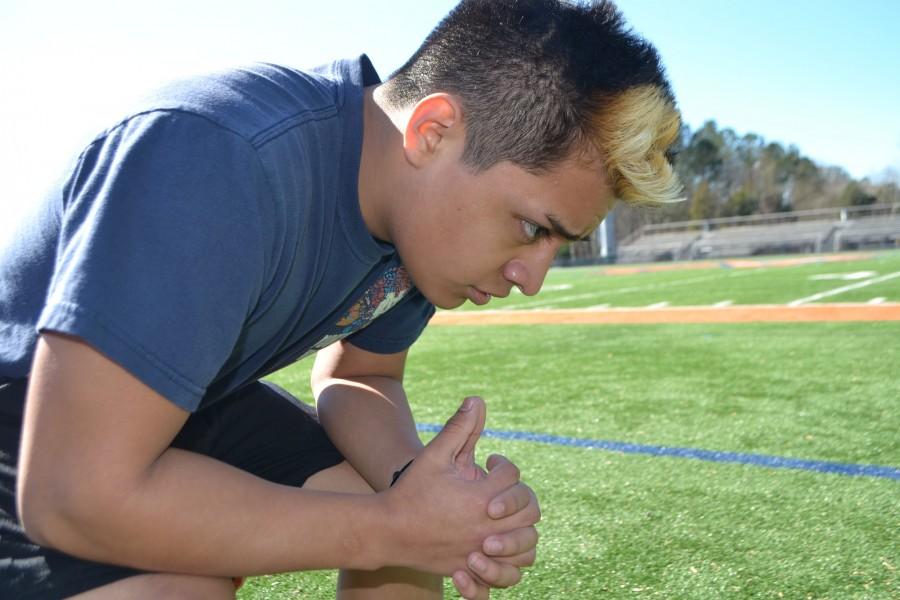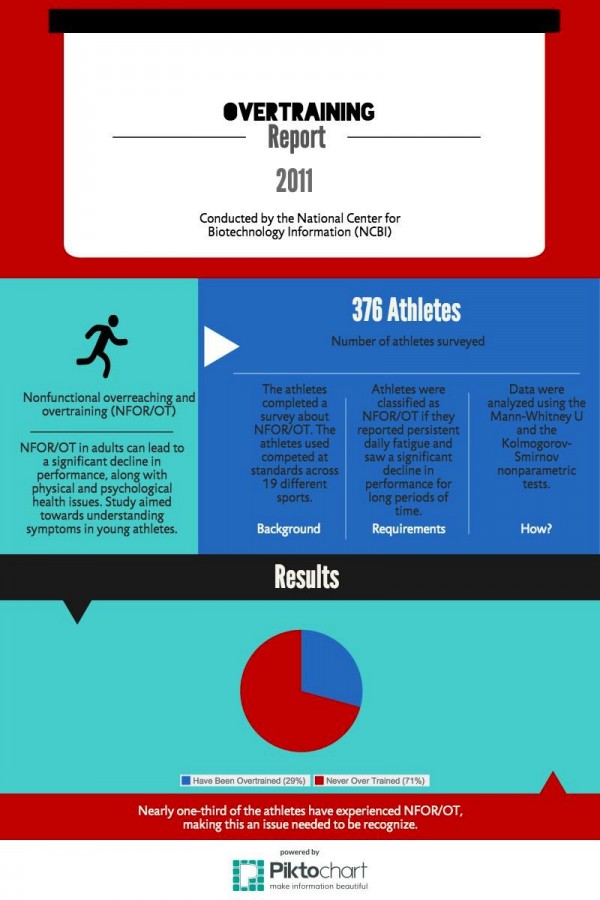Are you overtraining?: How to know your limits and manage stress
Overtraining symptoms mainly include fatigue and excessive exhaustion. In order to avoid this, it is essential to listen to the body when it tells the mind it is tired.
March 18, 2016
As the off-season progresses in the winter time, numerous athletes continue to maintain their strength and abilities by performing training activities. Once the season begins, the athletes hope their training effectively allows them to advance their progression and skills. Occasionally, the outcome of their first event may not match expectation. This can happen because of several reasons, but typically, overtraining.
Most athletes wish they knew if their scheduled training will pay off as they continue to perform their routines. This tends to enable overtraining, as they hope to return better than ever, oblivious to the fact their body cannot tolerate the amount of stress.
Stress results from demanding circumstances of the state of mental or emotional strain. Everybody copes with stress in their own separate matter, and for various people, exercise fends stress off.
The human body consists of the autonomic nervous system which primarily controls movements that happen without being told to do so, such as breathing. The system contains two primary branches, sympathetic and parasympathetic.
The sympathetic system controls the body’s “fight or flight” mode and the parasympathetic controls the body’s “rest and digest” mode. The sympathetic system’s duty often engages in a time of crisis, while the parasympathetic system occurs when the exhaustion overcomes the body and wishes for time to recover from the massive amounts of stress that it endures. When one starts, the other system ceases.
What does this have to do with training one may ask? When an athlete overtrains, they ignore their parasympathetic system, making them endure amounts of stress that will results in more harm and less athletic improvement. While the “fight or flight” mode activates, the body releases adrenaline and cortisol, which are both of limited supply. Resting replenishes the body of these necessities. While the body rests, it releases growth hormones and testosterone. This allows the body to recover and get stronger.

Numerous gyms offer classes for members that will allow them to perform to the best of their ability without over training. For example, YouFit on Jiles Rd in Kennesaw, GA offers personal training for members that seek professional assistance while at the gym.
So how can one can one replenish these nutrients? Simple: by taking a rest day. Giving the body nutritious food, water and ample rest will allow the body to feel better physically going into the next training session.
Phrases like “no rest days” do not make sense as the outcome offers more risks than benefits. They encourage people to train like their lives are a “Rocky” montage where they chase chickens and eat raw eggs for protein. One must realize that they must listen to how their body feels.
How does one know if they are doing too much, too little, or just right? Documentation of training solves this conundrum.
According to Greg Romero of BMX Training, “When I talk with a lot of athletes, I often find that they have little-to-no data proving that they are actually getting faster.” If an athlete’s tests show an increase in performance, their training works. If one feels like they train for a long time and do not progress, then change should occur. Resting and recovery will allow the body catch up to the stress it endured. The body will inform a person if it is overtrained.
Primary examples of overtraining include being unmotivated to train, needing caffeine to function, craving junk foods to eat, and struggling to concentrate. Other examples include exhaustion, performing below par, and sustaining an irritable mood.
Two or more of these symptoms call for one to temporarily reduce the volume of the current program in order to allow the body to regenerate.
Caffeine tricks one’s body into ignoring exhaustion as it artificially stimulates one’s “fight or flight” system by using chemicals. Do you take note on how your usual dosage of caffeine leaves you feeling flat? One’s overworks their adrenal glands and becomes exhausted because of overstimulation. Try going two to four weeks with a reduction in, or an absence of caffeine, to give your “fight or flight” system time to recharge.
Imagine adding the daily stress that everyone deals with at school or work to the stress your body endures from a training program. Doing your best to reduce stress in your everyday life, training in the right dosages, and allowing the proper amount of recovery will, in turn, increase performance.
Crocodile BreathingHRV Monitors prove a useful piece of technology that numerous athletes discovered to reduce stress and fatigue. HRV stands for Heart Rate Variability, the variation of time interval between each heart beat. Heartbeats often variate and the monitor creates a score that tells one’s state of readiness.
Some monitors can provide information on the Central Nervous System (CNS) and also the Cardiac System, plus give suggestions on how to best train for that particular day (such as the Omegawave Personal). A good suggestion indicates that one should use their method for a while and record the results in order to establish a baseline before radically adjusting training. One may notice certain types of training affect their CNS more than others.
A possibility includes a rise in heart rate. For example, during finals week at school, one’s heart rate may rise higher than normal. This indicates that one should consider changing/skipping training and emphasize sleep instead.
If one wants to workout but scores a poor HRV rating, they should consider doing aerobic conditioning work. Examples include walking, jogging, bike riding, or using the elliptical. 30-45 minutes with one’s heart rate around 120-150 beats per minute indicates a good starting point.
Aerobic conditioning rejuvenates the body by stimulating the Parasympathetic nervous system. A highly-developed aerobic system will also help recovery between break periods at events, and have more energy for the final day. These tests and recovery methods, when used properly, can help keep you at your optimal readiness.
Overall, training benefits an athlete’s journey to success. However, one must realize they can over train and potentially harm themselves more so than benefit. Athletes should listen to their body and take proper precautions in order to prevent this from occurring. Following the steps provided may allow an athlete to reach the performance they wish to achieve.









